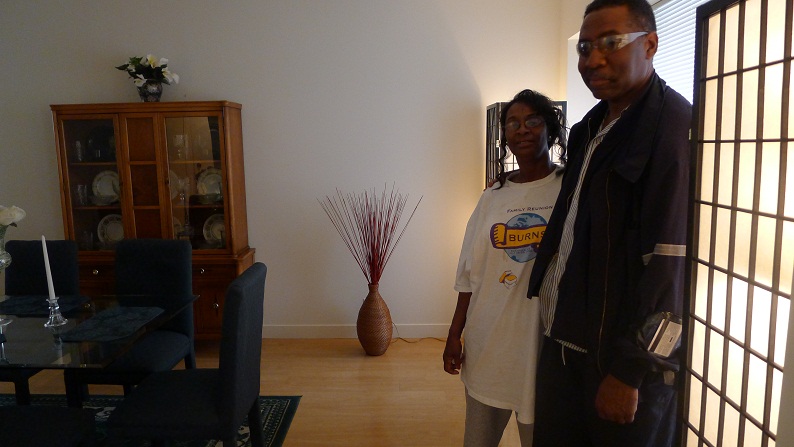Chicago’s new foreclosure strategy? More rentals
By By Ashley Gross

Chicago’s new foreclosure strategy? More rentals
By By Ashley GrossThis week, we’re examining how a city turns around neighborhoods that have been walloped by the foreclosure crisis.
The housing research organization Woodstock Institute reports that, since 2006, about 100,000 homes have gone into foreclosure in Chicago. But they’re not spread evenly. Some areas are barely hit; others are devastated.
Chicago has gotten millions of dollars from the federal government under something called the Neighborhood Stabilization Program designed to help neighborhoods recover. But finding the most effective way to spend that money has been a matter of trial and error. After initial stumbles, the city has now come up with an unusual strategy.
To see that new strategy in practice, we took a trip to Chicago’s Washington Park neighborhood.
There, we met Carl Moseley, who’s lived in the neighborhood for decades. He knows which are the good buildings and which are the not-so-good buildings.
For years, 6015 S. Indiana was one of the not-so-good ones. Moseley said it was a drug lair. It had tons of building code violations.
“It was a terrible building,” Moseley said. “People in our neighborhood – we would stay away from it. I have religious convictions where I talk to individuals in door-to-door work, and we didn’t really want to come near here. That’s how bad it was.”
Now he lives in that building.
“I happened to drive by, and I wanted to get a better place to live and I saw it and I couldn’t believe it,” Moseley said. “I saw the ceiling lights, the deck lights, that’s what attracted me to it, and I said I want to live in there.”
What had happened is that the city bought the building out of foreclosure and rehabbed it. So now this 46-unit building sports hardwood floors, newly remodeled kitchens, bathrooms, everything.
Moseley works for United Airlines and pays $725 for his two-bedroom apartment.

Turning around buildings like this one and creating apartments for low- and moderate-income people is the city’s new focus.
Since 2009, the city’s gotten $169 million dollars from the federal government to buy and rehab foreclosures in hard-hit neighborhoods. But buying such large buildings wasn’t top priority at first.
The city initially planned to spend 75 percent of its money on one- and two-unit buildings to fix up and sell, and spend the rest on multi-family rentals.
But as we explained in a previous story, the for-sale part of the program has been tough going.
So the city did a 180. It’s now spending 75 percent of its money on rental buildings like this one.
Katie Ludwig manages the program for the city.
“We always knew multi-family was going to be part of our strategy, we just didn’t realize how big a part of the strategy it was going to be,” she said.
The shift to rentals is welcome news to affordable housing advocates like Kevin Jackson of the Chicago Rehab Network.
He says he’s glad to see the city focus more on rental apartments that average people can afford – as a way to rebalance the housing stock that got out of whack in the boom years.
He says income numbers for households in Chicago average about $45,000 for a family of four.
“What we saw is incomes peaked in Chicago as in the rest of the country in the year 2000, so what we saw was a decreasing level of income to support what people wanted to do in terms of their commerce in the community, including housing,” Jackson said.
So even as home values were skyrocketing during the boom, people’s incomes were going down.
“That was part of the problem,” Jackson said. “We did not have a match with the supply of housing being created and the incomes that actually existed in Chicago.”
And while people may think of foreclosure as a scourge on single-family homeowners, lots of multi-family building owners have defaulted as well. In the past four years, foreclosures have affected almost 81,000 apartment units in Chicago, according to the Institute for Housing Studies at DePaul.
The 46-unit building on South Indiana was one of them. Since the rehab, Carl Moseley convinced his mom, his niece and a cousin to get apartments in the building.
His mom, Nellie Moseley, says there’s no comparison between her old place and her new one.
“One hundred percent better,” Moseley said. One reason why she decided to move to this building? Thieves ransacked her last apartment, a few blocks away, last year. She says she feels safer in her new home.
Rehabbing a big rental building like this one can go a long way toward helping an entire block recover, but it’s not enough. Just across the street from where the Moseleys now live is a boarded up building, and there are several more on the next block.
The housing crisis isn’t static – new places continue to fall into foreclosure. For the people managing the city’s foreclosure mitigation efforts, it can feel like Sisyphus pushing a boulder uphill endlessly.
Will Towns works for Mercy Portfolio Services, which runs the Neighborhood Stabilization Program for Chicago.
“Perfection is but a moment in time,” Towns said. “So we have a block where we’ve got all the assets done, that day everything’s great. The next day, who knows?”
Helping make a lasting change on a block requires all hands on deck, from police and the buildings department, to non-profits, to block clubs. That’s the approach Mayor Rahm Emanuel says he’s taking. We’ll hear more about how well that’s going tomorrow.
